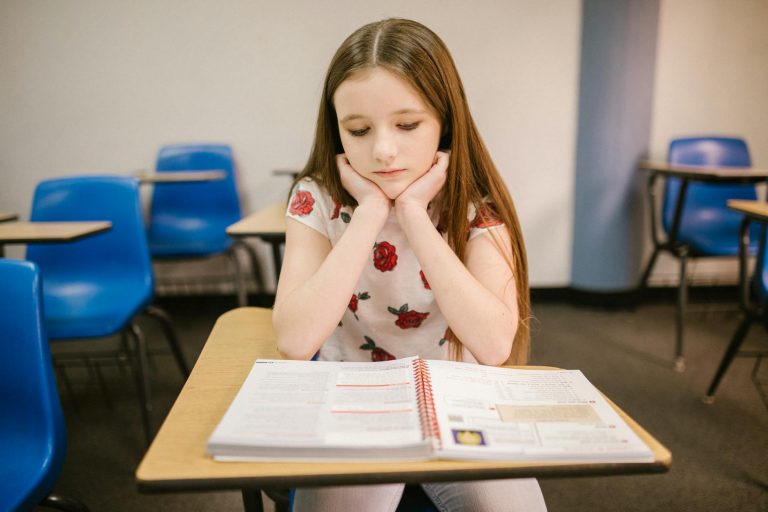What do ADHD girls in the classroom look like?
As an elementary school teacher, you are in a great position to spot young girls with signs of ADHD. You see her interact with others and perform classwork day in and day out. Your observations can help get her the timely evaluation she needs. But you might not recognize the signs of ADHD in the girls you see in the classroom.
Studies show that as many as two-thirds of teachers aren’t trained on the subject of ADHD. It’s a widespread and systematic problem. Many parents assume you’re trained to spot and help children with ADHD or learning disorders. But most teachers aren’t. The fact is, less than 10 states require coursework on students with neurodevelopmental disorders.
So, in this blog, we’ll look at possible ADHD symptoms, how you can talk to parents, and how to help with ADHD evaluations.
ADHD or something else?
First, it’s important to keep in mind that children can show signs of ADHD without having ADHD. For example, when does an energetic child become a hyperactive child? When does a child who doesn’t pay attention become an inattentive child. It’s not always a clear answer, and it’s not always ADHD. Sometimes, children’s behavior is due to other factors, such as issues at home. So, ask questions and watch for patterns of behavior.
Age is another consideration. Younger children are disproportionately diagnosed with ADHD because they haven’t reached the maturity level of their other older classmates. Children born in August are particularly vulnerable, since they are the youngest children in a classroom. A Michigan study found that the youngest kindergarteners were 60% more likely to get an ADHD diagnosis than older children in the same class. Make sure to compare a girl’s behavior to other children of the same age, not necessarily the same class. And realize that children with ADHD typically behave one or two years younger than their age.
The picture of ADHD
So, what are you looking for? You are probably familiar with the typical picture of ADHD —a rambunctious boy disrupting the classroom. But what about the girl gazing out the window and not paying attention to lessons? The girl who “isn’t living up to her potential”? She may be showing signs of ADHD.
“Girls may be more on the daydreaming side. They may appear shy, withdrawn, daydreaming during class. Looking out for those signs is just as important as looking out for the kids getting out of their seats or blurting out answers.
Those kids who are inattentive may appear to be just fine during class. They may be struggling because they’re daydreaming, and they may miss a lot of things.”~ Carrie Jackson, PhD, specializes in child ADHD
The picture of ADHD
So, what are you looking for? You are probably familiar with the typical picture of ADHD —a rambunctious boy disrupting the classroom. But what about the girl gazing out the window and not paying attention to lessons? The girl who “isn’t living up to her potential”? She may be showing signs of ADHD.
“Girls may be more on the daydreaming side. They may appear shy, withdrawn, daydreaming during class. Looking out for those signs is just as important as looking out for the kids getting out of their seats or blurting out answers.
Those kids who are inattentive may appear to be just fine during class. They may be struggling because they’re daydreaming, and they may miss a lot of things.”~ Carrie Jackson, PhD, specializes in child ADHD

Inattentive type ADHD is most common in girls, and subtle symptoms can be easily overlooked. But remember, ADHD isn’t a one-size-fits-all and shows up differently in everyone. Girls can show any mix of ADHD symptoms, including impulsivity, hyperactivity, and inattention.
When does ADHD show up in the classroom?
It may take some time for inattentive type ADHD to show up in the classroom. ADHD brains are switched on with novelty, and for the first week or two, school is a new, exciting experience! But after a few weeks, you may start to notice signs of possible ADHD.
Inattention usually doesn’t show up in the first week because novelty is energy. And so inattentive kids often have a very good first week, maybe two, and then start to slide. But by that time, the teacher may have already constructed the worry list and may have some bigger fish to fry.”
~ Oren Mason, MD, ADHD specialist
Mindset shift for spotting ADHD in girls
Miriam Shaffer is a special needs educator for neurodevelopmental disorders. For teachers, she suggests you forget everything you think you know about ADHD and ask these questions:
- Does the student ever forget what they’re supposed to be doing?
- How long does it take them to get started with their work?
- How often do they manage to finish the work within the allotted time?
- Do they seem more emotional than other students?
- Do they get frustrated or give up easily?
- Have you noticed any sudden mood changes?
- Do they have low self-confidence?
Asking these questions can give you a good framework to start with when you are observing your students.
ADHD signs you may see
Executive Dysfunction
ADHD causes difficulty with executive functioning skills, including organization and working memory. Girls may have difficulty following spoken directions, especially when it involves more than one step. She may forget a step or two, even when it’s something she does every day.
Here are some other signs of executive dysfunction you may see:
- Doesn’t have a clear understanding of how long something will take
- Is often rushed or running out of time
- Procrastinates starting something that seems boring or hard
- Needs frequent reminders or cues, even about routine activities
- Struggles to break down big tasks into smaller steps
- Easily frustrated with challenges, quick to give up
- Needs lots of encouragement or incentives to stay on task
- Difficulty keeping track of her belongings and losing things often
- Messy desk or backpack, crumpled papers
- Struggles to pause before acting or speaking
- Difficulty focusing on tasks at hand
- Struggles with self-awareness
Academic Issues
ADHD girls often sense they could do better, but there is some block that keeps them from it. But better doesn’t always refer to better grades. Girls with ADHD may have perfect marks. Or not. But the question is, how are they handling schoolwork or test pressure? Are they anxious or extremely rigid? These things can give you a clue into how they’re feeling. Girls with ADHD can often compensate up to a point before their coping strategies fail.

Perfectionism
- Not living up to her potential
- Just needs to apply herself more
- Could do better if she tried harder
These are common phrases on a report card of a girl with undiagnosed ADHD. It doesn’t take long for girls to internalize these comments. Trying to live up to expectations and avoid missing details, many ADHD girls become perfectionists with anxiety.
Watch her closely if you notice she’s trying much harder than other students—even if she’s keeping up with her schoolwork. Girls can often meet academic demands in elementary school, but their grades don’t always reflect what’s happening. So, pay attention to the effort your students put in.
An imbalance of effort and performance
Effort versus performance can be especially telling when looking at homework versus exams. If your student is consistently performing well on homework assignments but fails tests? She may not have enough time to recall the information and complete the test. This isn’t a lack of knowledge; it’s due to a slower processing speed in the brain. The opposite can also be true: great exam performance but difficulty doing homework. If there is an imbalance between the two, question why. It warrants exploration as many women who grew up with undiagnosed ADHD live with a chronic feeling of unexplained under-achievement.
Math and Reading Challenges
Slower processing speed and executive function challenges like impaired working memory can make reading and math difficult for girls with ADHD. For example, she may read faster than she comprehends what she is reading. To process and retain the information, she may have to read a passage several times. Similarly, math problems, especially those with multiple steps, are challenging for ADHD girls.

Sensory Issues
Girls with ADHD can have sensory issues with certain stimuli, including noise. Even in the best circumstances, classrooms are noisy places. Does she complain about the noise? Or does she seem overly distracted by sounds? This sensitivity can apply to the uproar of free playtime to the almost imperceptible humming of an air conditioner or fluorescent lights. The issue may seem overblown, but she likely isn’t being “dramatic.” ADHD and sensory processing issues often go hand-in-hand.
Emotional Challenges
“If you don’t give your kid an explanation for what they’re struggling with, what they make up is a whole lot worse, and they’re going to make up that they’re lazy, crazy, or stupid.”
~ Liz Adams, neuropsychologist specializing in ADHD
Anxiety/Depression
ADHD makes children more prone to anxiety and depression. In fact, children with ADHD are 3x more likely to have an anxiety disorder than children without ADHD. And up to 14% of children with ADHD have depression as opposed to 1% of children without an ADHD diagnosis.
Low self-esteem
Girls with ADHD often struggle with their self-esteem. They know something isn’t right. You may hear her say things like, “I can’t do anything right,” or “I’m so stupid.” She is trying her best, but it doesn’t seem like enough. She may be especially hard on herself, or take all corrections personally. It’s unfortunate, but it makes sense. She doesn’t know that her brain is wired differently, she only knows that she’s struggling.
Emotional Regulation
Emotional regulation, or self-control is hard for children with ADHD. And it can be overlooked, or attributed to personality—especially in girls. Watch for frequent emotional outbursts. If she constantly feels overwhelmed, she’ll be more sensitive.
Social skills
You may also notice she has problems with her classmates. Girls can have trouble with social relationships and regulating their emotions. They may have difficulty interpreting social cues or miss them altogether. This has a big impact on social interactions with her peers. Girls with ADHD may be shy or introverted and prefer to play by themselves.

On the other hand, she may be very chatty: a social butterfly. Even if she’s very social and makes friends easily, a lack of impulse control may cause chaos in her relationships. So, if she’s able to make friends, can she maintain them? She may have trouble seeing things from someone else’s point of view and interrupt people. Her classmates may view her as rude or bossy.
“I was too much: too loud, too expressive, too messy, too many questions, too weird, too… everything.”
~ Angie Mack, performing artist with ADHD
Track her behaviors and your observations
So, you’re observing these possible signs of ADHD. Now what? First, keep track of her behaviors. How often do they occur? How severe or intense are they? Jot down specific examples of what you are noticing. This information is invaluable to have when you talk to her parents.
Talking to parents about possible ADHD in their daughter
Parents can sometimes be defensive when presented with their children’s challenges. ADHD, especially, is a loaded topic. For years, the myth has circulated that ADHD is caused by bad parenting, not differences in the brain. Per a 2019 study, 25% of surveyed teachers indicated their belief that ADHD was caused by bad parenting. Of course, this is untrue. But this shows how pervasive this belief still is, and how it still impacts perceptions of ADHD in children. You will do well to keep this in mind as you approach these discussions with parents.
Take a positive, collaborative stance
Ask for a conference and create a private space and time to talk to her parents. It may be helpful to acknowledge from the beginning that they are the experts on their daughter. After all, they are! But tell them you’d like to share some things you’ve noticed and ask for their feedback. This attitude helps parents see you as a partner, not a critic. Be gentle and empathetic, and lead with her strengths.

Use specific examples
When it is time to address the behaviors that concern you, use specific examples. Instead of saying, “Your daughter has trouble paying attention,” let them know what you’ve seen. You could say, “When your daughter has a math problem to solve, she starts doodling.” Or “I have to remind her multiple times to start an assignment.”
Don’t tell parents that their child has ADHD. You can suspect, you can’t diagnose.
Depending on your school’s policy, you don’t have to mention ADHD at all. Or, you could say something like, In my experience, these could be signs of ADHD. Remember, you’re not diagnosing ADHD; you’re only communicating your observations and concerns. Encourage the parents to share their thoughts. Whether ADHD is brought up or not, suggest that they follow up with their daughter’s pediatrician as soon as possible.
Partner with parents
In the absence of training and education, a well-informed parent is your best ally. Let them know you’re available to provide your observations and notes with an evaluating provider. Continue to work together and create the best possible outcome for their daughter. Sharing insights about what works and what doesn’t helps establish expectations and consistency between her home life and school life. This is crucial for supporting girls with ADHD.
Here’s what one mother had to say:
“As her mom, it is frustrating that it took so long to figure it out. I wish I could erase all those years she struggled, as well as my own frustration with her. If I’d known about the signs of ADD in girls and comorbidities, I could have helped her earlier.
But, in the end, it took just one observant and caring person ― her teacher ― seeing who she really was, taking the time to look a little deeper into what she needed and believing in her. She left an indelible mark on Ella’s life, a gift she will carry with her forever.”
~Lisa McCarty, ADHD mom (for the full story, click here)
Final thoughts on identifying ADHD girls in the classroom
As an elementary school teacher, you are in a unique position to help identify girls with ADHD. You see them every day and know their strengths and areas they could improve. Just like Lisa’s experience illustrates, you can change your student’s life forever. Keep track of your observations and share them with her parents. Together, you can make sure she has early intervention and the help she needs to succeed now and in the future.
Enjoyed this article? Check out this chart for ways to accommodate students with functional ADHD impairments.
Co-Authors
 Alex Alcon
Alex Alcon
Alex Alcon, RN, Freelance nurse content and copywriter, owner of RN2Pen LLC
 Cynthia Hammer, MSW
Cynthia Hammer, MSW
Cynthia Hammer, MSW, is an ADHD advocate helping girls get timely diagnoses. She’s the founder of FINDtheADHDgirls, Executive Director of the Inattentive ADHD Coalition, and author of Living with Inattentive ADHD.
Share via:

